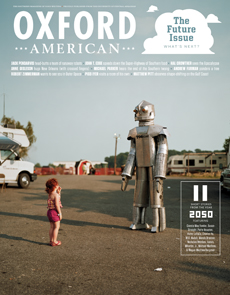Short Fiction Review #33: Oxford American Future Issue
 Oxford American Issue 70 contemplates life in 2050 with 11 stories that share a pessimistic view of America’s future beset by natural and man-made disaster, human folly and avarice. In other words, just like it is today, only worse.
Oxford American Issue 70 contemplates life in 2050 with 11 stories that share a pessimistic view of America’s future beset by natural and man-made disaster, human folly and avarice. In other words, just like it is today, only worse.
While dystopia has always been a fundamental science fictional trope (indeed, the one that has historically been most likely to gain literary credence, e.g., Brave New World and 1984), there was a time, particularly during the Golden Age of the 1930s to 1950s but still continuing on in counterpoint to the New Wave movement during the 1960s/1970s, when writers portrayed a future improved by technology, not devastated by it. Even the cyberpunks, despite their bleak industrial noir settings, arguably depicted technology as a “force for good” when their renegade heroes turn the technological tables to upend the corporate masters.
Part of the bleakness here might be because Oxford American terms itself “The Southern Magazine of Good Writing,” and the American South certainly has a collective consciousness of disasters dating back to the Civil War, but most recently with Katrina and the BP oil spill in the Gulf. “The Vicinity of the Sick” by M.O. Walsh depicts a Louisiana where people have to wear bio-hazard suits to go in the water; a woman dying of cancer is driven by her reluctant husband to a restricted biohazard in hope of escaping the soul-sapping hazards of technological illusions that pervade “normal” existence in Connie May Fowler’s “Do Not Enter the Memory”; and a strange pair from opposite socio-economic backgrounds try to survive (and discover some basic bond of humanity) in the Bayou following ecological and technological collapse in “Maroon” by Susan Straight. Along the same lines, in a non-fction piece, Kevin Brockmeier lists his “Ten Great Novels of the Apocolypse.”
In addition to ecological disaster, the stories share to varying degrees the usual suspects for end-of-the-world scenarios: the amoral corporate focus on the bottom-line and self-interest, the numbness of media and advertising that leads to unhealthful lifestyles, medical advances that keep people biologically alive in bodies long past expected mileage.
Many of these, however, seem primarily interested in establishing a depressing future scenario and leave it at that. Wendy Brenner’s “The Last Rehab” is funny in a Vonnegutian kind of way, somehow managing to simultaneously satirize life extension technologies and substance abuse rehab. Similarly, “Twenty Hearts a Day” by James Whorton, Jr. is a first person narrative of an old man’s guarded optimism in getting a heart transplant, even in the face of lifelong disappointment. “Wargasm” by Patty Houston takes today’s growing intolerance of cigarette smoking (still an economic source in the tobacco growing South) to the next level with a parable of how even good intentioned social mores can lead to violence against those who don’t conform. Along the same lines, the epistolary “The Age of Happiness” by Nicholas Rombes is an exchange between a man and his lover who has joined the Disruptors, eco-terrorists bent on destroying the technological pacifiers that keep people stupefyingly content. The weirdest is “Viral Free-Floating Critical Commentary” in which Michael Marton presents a pastiche that has something to do with resurrected William Faulkner, complete with footnotes, that has a couple of funny lines but little coherence, one of those stories that seems intended to impress upon you how clueless you are, even if you were an English major.
“Designer Emotion 67” is Charles Yu’s pitch-perfect spoof of corporate self-interest by companies purportedly in the business of improving people’s lives, in this case an advertising, pharmaceutical, entertainment conglomerate BBDO/Pfizer/Dreamworks, Ltd.:
…Depression has been good to us. But at this point, as you all realize, it has come to be run as an exercise is sales and marketing. We’re late in the product cycle. The Depression-industrial complex has been built. Winning in the Depression/Suicide space these days means keeping the machine running smoothly…This is what you care about: bottom-line. Which is this: Depression earned three forty-tow a share last year, or just over a half billion dollards for B/P/D. Not depressing at all!
p. 99
My favorite story is “The Artificial Heart” by Megan Mayhew Bergman. The narrator is the caretaker for her 91 year old father, kept alive by the titular modern marvel past the warranty of both his body and his intellect. The father wants to go out on a “fishing trip” with another similarly memory-impaired women he has been “dating” for the past month, thanks to their children who wheel them in for assignations the two old people soon forget they’ve had. The Senior Center cannot sanction such an outing and, besides, the center’s director says, “What’s there to fish for anymore?”–the underlying metaphor of the story being “what is there to live for” when a person is drowning in dementia. The fishing trip at first seems to take disastrous terms on both personal and ecological levels, but leads to the narrator’s realization that no matter how awful existence seems to become, human relationships, no matter how battered, can persevere.